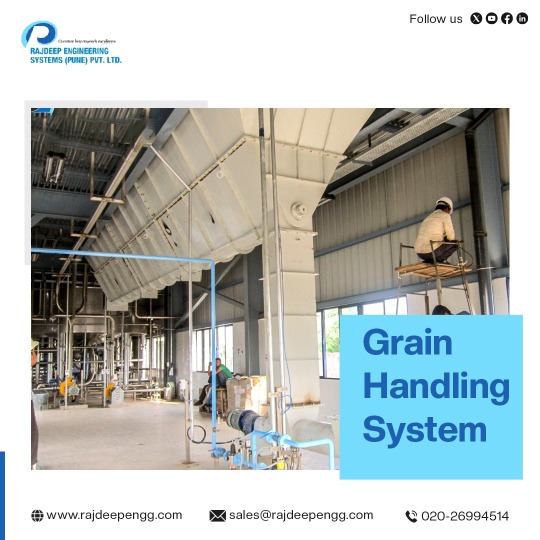Text
Enhancing Productivity: A Definitive Guide to Optimizing Grain Handling Systems

Grain handling systems play a pivotal role in the agricultural industry, facilitating the efficient movement and storage of grains from farm to market. Grain handling systems encompass a range of equipment and processes designed to handle, transport, store, and process grains such as wheat, corn, barley, and rice. With the ever-growing demand for grains globally, optimizing grain management systems is crucial for maximizing productivity and minimizing losses.
At the heart of any grain management system lies the grain elevator, a vertical structure equipped with conveyor belts or buckets that lift grains from ground level to silos for storage. These elevators are essential for transferring grains between various stages of production, from harvesting to storage and distribution. Modern elevators employ advanced technology to streamline operations and ensure the gentle handling of grains to prevent damage and maintain quality.
Conveyors are another integral component of grain handling systems, offering a flexible and efficient means of transporting grains within facilities. Belt conveyors, screw conveyors, and pneumatic conveyors are commonly used to move grains horizontally or vertically, allowing for seamless integration with other processing equipment. By automating the transport process, conveyors enhance productivity while reducing labor costs and the risk of manual errors.
Storage is a critical aspect of grain handling systems, influencing the quality and shelf life of grains. Silos are the primary storage structures, capable of holding large quantities of grains in a controlled environment. Equipped with ventilation systems and temperature monitoring devices, silos ensure optimal conditions to prevent spoilage caused by moisture and pests. Additionally, modern silos are designed for easy loading and unloading, facilitating quick turnaround times during peak harvest seasons.
Grain drying is another essential function performed within grain handling systems to reduce moisture content and preserve quality. Drying bins or towers utilize heated air or natural airflow to remove excess moisture from freshly harvested grains, preventing mold growth and ensuring safe storage. By expediting the drying process, these systems enable farmers to harvest grains at the optimal moisture level, maximizing yields and profitability.
In recent years, automation and digitalization have revolutionized grain handling systems, offering real-time monitoring and control capabilities. Advanced sensors and software systems allow operators to remotely manage equipment, monitor grain conditions, and optimize workflow efficiency. Predictive analytics and machine learning algorithms provide valuable insights into grain quality and storage conditions, enabling proactive maintenance and decision-making.
In conclusion, grain handling systems are indispensable assets for the agricultural industry, facilitating the efficient movement, storage, and processing of grains. By embracing technological advancements and best practices, farmers and grain handlers can optimize operations, minimize losses, and meet the growing demand for grains worldwide.
#Grain Handling System#Grain Management System#Rajdeep Engineering Systems#Industries Plantation and Machinery
0 notes
Text
Maximizing Agricultural Efficiency: Exploring the Grain Handling System

In the intricate tapestry of modern agriculture, the grain handling system stands as a linchpin, orchestrating the seamless movement of grains from field to storage with precision and efficiency. This vital system encompasses a suite of equipment and processes designed to optimize every facet of grain management, ensuring minimal loss and maximal yield.
At the heart of agricultural productivity lies the harvest, where the journey of grain handling begins. Employing cutting-edge machinery such as combine harvesters, farmers efficiently reap the fruits of their labor from expansive fields. This initial step sets the stage for the subsequent stages of the grain handling process.
Storage represents a cornerstone of the grain handling system, necessitating facilities that provide optimal conditions for preserving grain quality. Silos, bins, and warehouses equipped with state-of-the-art temperature and moisture control mechanisms ensure that grains retain their integrity and nutritional value over extended periods, safeguarding against spoilage and loss.
Transportation emerges as a pivotal stage in the grain handling continuum, demanding reliable conveyance systems to ferry vast quantities of grains from field to storage or processing facilities. Belt conveyors, screw conveyors, and pneumatic conveyors serve as stalwart allies, facilitating the safe and efficient movement of grains while mitigating the risk of damage or contamination.
The advantages conferred by an efficient grain handling system are manifold. By minimizing losses attributable to spoilage, damage, or inefficiencies in handling, farmers can optimize their yields and bolster their bottom lines. Moreover, the streamlining of grain handling processes engenders broader operational efficiencies, freeing resources and attention for other critical aspects of agricultural enterprise.
Beyond mere storage, the grain management system encompasses ancillary processes crucial for maintaining grain quality and marketability. Grain cleaners diligently expunge impurities such as dust and chaff, while grain dryers staunchly combat excess moisture, thwarting the insidious advance of mold and decay.
In summation, the grain handling system emerges as an indispensable linchpin in the tapestry of modern agriculture. Through the integration of advanced equipment and meticulous processes, farmers and grain handlers can orchestrate the seamless movement of grains with unparalleled efficiency, ensuring the continued prosperity and sustainability of the agricultural sector.
#Grain Handling System#Grain Management System#Rajdeep Engineering Systems#Industries Plantation and Machinery
1 note
·
View note